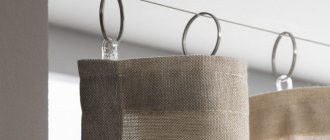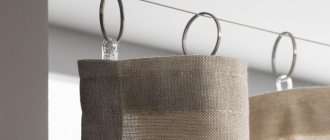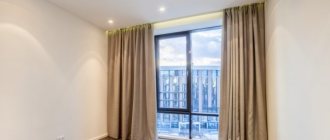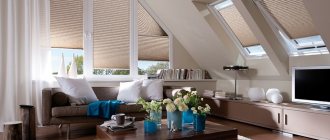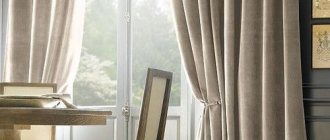The final decoration of a living space includes many small tasks: selection of textiles, accessories, purchase of curtains, cornices. Much attention should be paid to the design of the window opening. Especially – the choice of cornice. It is this small detail that makes the interior harmonious and complete. However, there is no need to rush into buying a cornice. First, you need to carefully familiarize yourself with the options on the market and their advantages. This article explains this in more detail.
When choosing a window design, you should pay attention not only to the curtains, but also to the element on which they are attached.
Advantages of wall cornices
A real plus for the buyer will be the large selection of models that accessory manufacturers present to customers today. It is also worth noting the following advantages of wall-mounted curtain rods over ceiling models:
- Convenient fastening.
- Ability to support much greater weight.
- The presence of two-row and three-row cornices, which allows the use of combined curtains in the interior.
- Installation of the structure does not require the help of a specialist, which is beneficial in practical and financial terms.
Another advantage is the fairly wide price range, so buyers can calculate their expected expenses.
Dependence of length on opening width and fabric for curtains
Most designers consider it blasphemous to choose a cornice whose size is equal to the width of the opening. Sometimes you can argue with them. In some cases, purchasing a product of a different length is unrealistic. The window can be located, for example, between a wall and a semi-column. Any other size simply will not fit into the opening.
This footage helps to adjust the size of the opening. Indeed, in this case, when the curtains are opened, the opening will partially open. They remain on the window and do not go to the wall. This technique can visually make windows smaller.
This length is appropriate if there are no thick night curtains. The opening is draped with tulle or other lightweight material. The light will flow in the proper amount, and there is no need to move the textiles. Roman blinds also dictate the fashion for curtain rods according to the size of the window.
Listening to the advice of designers, you should choose the length based on the width of the opening plus 10-25 cm on each side. The length will allow the curtains to be moved back onto the wall, and the light will penetrate in full. The curtains will hang in spectacular flounces, which will allow you to create beautiful drapery during the daytime. Such a mount will demonstrate the window in full size without distorting the size.
But if the existing dimensions are not enough, then they resort to increasing the length by 25 cm or more. It is better to calculate the size of the increase with the help of a seamstress. She will tell you exactly how much space is needed to effectively arrange the curtains. In this case, it is necessary to have wide partitions, so that the size of the room is not distorted. With such a cornice, the flounces will be smooth, and the drapery can be moved apart much more.
If you choose thick and heavy fabric for sewing curtains, you should increase the length by another 10-15 cm on each side. Otherwise, the material will simply wrinkle and lose its original attractive appearance.
Choosing material for cornices
The material used to make the curtain rod - wall or ceiling - must be durable and able to withstand the weight of the curtain. Also, before purchasing a particular model, a number of parameters are assessed: care requirements, resistance to high temperature, moisture, detergents.
In furniture and accessories stores you can find wall cornices made from the following materials:
- Wood.
- Metal cornices.
- Plastic models.
- Aluminum options.
Each of the presented options has a number of distinctive features, advantages and disadvantages. The choice of model often depends on the interior style of the living room, kitchen or dining area.
Types of curtain fastening
Curtains are attached to the cornice in different ways. Here are the most common ones:
- On decorative braid. A special braid with a cord is sewn into the upper edge of the fabric. By tightening the lace, you can get a beautiful and uniform drape of the material.
- On the eyelets. For such fastening, metal rings are punched in the upper part of the canvas. They are the ones that are strung on the cornice, ensuring the mobility of the curtain.
- On hinges. This type of fastening implies the presence of fabric loops. They can be tied, fastened with buttons or Velcro. In this case, the loops can be wide or narrow, forming bows or beautiful ties.
Wooden cornices
Some of the most beautiful products supplied to the building materials market by manufacturers. They are distinguished by their durability, pleasant natural shade, resistance to moisture and detergents (with optimal surface pre-treatment).
In addition, the advantages include excellent environmental performance. Fibers of various types of wood do not contain allergens and do not emit toxic fumes when heated.
Window decoration
The size of tulle and curtains directly depends on:
- curtain type (Roman or curtains);
- cornice lengths;
- parameters and features of the window opening;
- the general idea of the designer.
In order to avoid annoying mistakes when purchasing curtain fabric, you need to correctly calculate the size of the curtains.
If one of these factors is not taken into account, it will be difficult to correctly calculate the sides and area of the product. Accordingly, the aesthetic part of the enterprise is at risk.
If the tulle is too short, it will not be able to fulfill its direct function - to diffuse sunlight and complement the design of the room. This is especially true for the living room, because a flaw catches the eye and spoils the overall impression and mood.
The choice of cornice depends on the design of the room, the size of the surface to be decorated, the style of the curtains, the weight and texture of the fabric, and the method of its fastening, on the wall or ceiling.
If the curtains in the bedroom are not long enough, they will not be able to fully darken the space. And excessively large dimensions look untidy, and besides, it is unsafe. They are inconvenient to handle in everyday life, and they also get dirty quickly.
Manufacturers of home accessories have taken into account all the nuances; today you can buy products of standard sizes that are suitable for all typical rooms.
It’s the same story if the width for the curtains is chosen incorrectly: functionality is impaired, aesthetics are absent, and the overall impression is reduced. And curtains that are too wide usually just mean an untidy look.
When designing exclusive interiors, you can order a fastening system based on an individual project.
Metal curtain rods
To make a durable frame, manufacturers use various alloys that have a set of positive properties:
- Particular strength.
- Moisture resistant.
- Corrosion resistance.
- Beautiful decorative coatings.
- Ability to withstand significant weight, especially when using double curtains.
Special luxury is given to such products by tips and fittings made in various shapes (pointed peaks, figured domes). Thanks to additional details, cornices act as an independent element of the interior.
We calculate wisely
How to calculate the fabric for curtains - such a task seems difficult to accomplish, but this is only at first glance. You just need to know that the required footage is determined by the sum of several terms:
- curtain length,
- width multiplied by the build factor,
- allowances for processing edges,
- allowance for possible shrinkage of the fabric,
- reserve for the symmetry of the pattern if the curtains have a large repeating pattern.
Measurements are more accurate when using a long metal tape measure rather than a flexible measuring tape.
Calculation of fabric length
First, find the distance from the cornice to the desired end point - the floor or window sill. This will be the finished length of the product. According to the wishes and ideas of the home owners, curtains can:
- reach the floor, 1-2 cm without touching it to avoid wear,
- reach the floor and lie on it with a “trail” of 5 to 10 cm,
- be the length of the window sill, without reaching the bottom edge of the curtain to its surface by 1 cm,
- fall below the window sill by 10-15 cm.
Then, for a more accurate calculation of the fabric, you need to know the method in which the curtain will be hung on the cornice. There are several types of fastening:
- A special curtain braid, the loops of which will catch the hooks of the curtain rod. Two strong threads are stretched along the ribbon for a neat and beautiful assembly of the fabric. If, for example, the braid is 7 cm, you will need 14 cm of fabric for a double hem. Plus 2-3 cm on the side at the top.
- Loops or ties sewn to the top finished edge of a curtain.
- Clothespins, clips, hooks. In this and the previous cases, a technological allowance of 2-3 cm is given to hem the top of the fabric.
- The drawstring is a kind of tunnel along the top of the product through which the rod of a round cornice or string line passes. To the total footage you will need to add the double width of the drawstring (it can be from 3 to 20 cm).
- Eyelets are plastic, wooden or metal rings driven into holes along the top of curtains. Then the width of the lining tape (from 10 to 20 cm) is added to the total number of meters, which is glued from the inside to seal the fabric and allow the eyelets to move along the rod.
Calculation of material by width
The fabric consumption for curtains by width is calculated taking into account three parameters:
- cornice length;
- fabric gathering factor;
- allowances for processing side seams.
First, the working length of the supporting rod of the cornice is measured. According to the rules, the cornice should protrude 20-25 cm from the window on both sides, so that the curtains can be freely moved apart to provide sufficient illumination of the room. The resulting value is multiplied by the gathering factor (folds). It is sometimes called the fluffiness factor. Uniform, beautiful drapery is associated with the density and texture of the fabric. The thinner and more airy the matter, the greater the amount will be permissible. So, for tulle and organza the gathering factor will be from 2 to 4, for heavy ones - 1.5-2.
For example, with a cornice length of 3 m, calculating the width of one curtain looks like this:
3 m: 2(number of panels) x 2(assembly ratio) = 3 m(width of one panel).
To the resulting figure, do not forget to add 2 cm on each side for processing the side edges. You also need to take into account a small allowance of 5-7 cm for the overlap at the “meeting” point of the drawn curtains.
The number of folds also depends on the presence of the pattern: the larger it is, the less the curtain needs folds, since they will only interfere with the perception of the texture of the material.
Shrinkage allowance
To hem the bottom edge of the curtain, add 5-8 cm to the length of the finished product, insuring yourself in case the canvas “shrinks,” that is, decreases in size both in length and width. This reserve depends on the type of fabric: natural fabrics made of cotton, wool, silk, linen shrink more, up to 10% of the original length. According to all the rules of sewing technology, before cutting any product (clothes or curtains), all fabrics must undergo decatification - soaking in water or steam treatment. This is done so that the fabric has time to “shrink” in advance and the inevitable washing does not deform the already sewn item.
Stock for curtains with large prints
A large (floral or geometric - it doesn’t matter) pattern on both curtains should be located symmetrically for an aesthetic appearance.
First, one canvas is cut. Then the remaining fabric is placed side by side, the pattern on both halves is combined, and only then the second curtain is cut out. The yardage of fabric for curtains with large patterns is always increased by the length of the repeating motif - the so-called rapport, and for each panel. The amount of rapport is determined by the boundaries beyond which the pattern is repeated.
For example, if two curtains have a length of 5, and the repeat length is 40 cm, then you will have to buy 5 m 80 cm (5 m + 40 cm + 40 cm). The larger the drawing, the greater the financial costs for additional centimeters.
Aluminum curtain rods
Aluminum differs from other metal bases in a number of advantages:
- Very light weight product.
- Laconic form.
- Nice glossy shine.
The material has significant flexibility, but at the same time, is resistant to corrosion.
Russian standards
Domestic manufacturers have long known how long curtain rods should be. Thanks to Russian GOSTs and other standards, manufacturers traditionally produce curtain rods of three meters. This is due to the ergonomics of the premises and the design characteristics of the windows. In recent years, the assortment has begun to expand; stores increasingly offer products of other lengths, although they are also fixed.
Choosing a three-meter cornice is as easy as choosing any other type. It is worth paying attention to what material it is made of. The diameter of the pipe plays an important role. To begin with, it is worth deciding on the general concept of window design. The diameter will be important if the curtains that are chosen are very massive and large. Thick cornices will not be able to bend and ruin the view.
Types of cornice construction
Depending on the number of support rods for the placement of the textile fabric, the following types of construction are distinguished:
- Single row wall cornice. Designed for attaching one curtain (tulle, light kitchen curtains).
- Double row wall cornice. They are universal models, most often found in practice. Perfect for classic interior styles, as it allows you to use two types of curtains (for day and night use).
A more rare type is three-row cornices. Used for using multi-layer original ensembles of fabrics.
Useful tips
To correctly calculate at what height to hang the curtain rods, measure the height of the wall from the horizontal slope to the ceiling, divide the parameter by 3. 1/3 is the distance from the ceiling, 2/3 from the slope.
If the wall is narrow, give preference to models with ceiling mounting. If you decide to hang wall curtain rods, remember that the distance from the horizontal slope to the bottom edge of the bracket must be at least 50 mm.
A deviation from the width of the window opening of 0.15-0.4 m is not just a design trick for aesthetics; this distance allows you to move the curtains back as far as possible in order to fully open the window, which is important for dark rooms.
When choosing a fastening system, be guided by the interior design and curtain model
How to choose a cornice
You can choose a suitable cornice for interior decoration by following a number of rules:
- You should first evaluate the combination of the canvas and the selected cornice model.
- It is necessary to take into account the area of the room, the width of the window opening, and the height of the ceilings.
- Calculate the number of curtains for one cornice and choose the appropriate type of design.
- Before purchasing a product, it is better to evaluate its resistance to moisture, detergents, and high temperatures.
An assessment of the ability to withstand significant weight of textiles is mandatory.
What should be the height of the ceiling plinth?
Professionals recommend choosing baguettes no more than 8 centimeters wide for low ceilings not exceeding 2.5 meters in height. If you need to decorate a room with a high ceiling (from 3 meters and above), you need to choose wide moldings, at least 8 centimeters.
Interesting materials:
How many times should you go to the gym? How many push-ups should a girl do? How many times has Cyberpunk 2077 been postponed? How many times should an Ectomorph train? How many times a year can you go to Thailand? How many times a year can the cadastral value be reduced? How many times a year does Andrei have a name day? How many times a week can you eat eggs? How many times a week can you go to stretching? How many times a week should you go to the gym?




